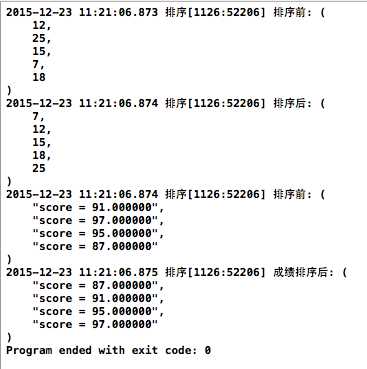标签:
在Objective-C中,排序分为:
1、Foundation框架中的对象排序
2、自定义对象排序
例子:每个学生都有一个成绩score属性,根据成绩score对学生排序
自定义对象 Student.h

Student.m

main.m
#import <Foundation/Foundation.h> #import "Student.h" int main(int argc, const char * argv[]) { @autoreleasepool { //1、Foundation框架中的对象排序 NSArray *arr = @[@12, @25, @15, @7, @18]; NSLog(@"排序前: %@", arr); // 注意: 想使用compare方法对数组中的元素进行排序, 那么数组中的元素必须是Foundation框架中的对象, 也就是说不能是自定义对象 NSArray *newArr = [arr sortedArrayUsingSelector:@selector(compare:)]; NSLog(@"排序后: %@", newArr); //2、自定义对象排序 Student *stu1 = [Student new]; stu1.score = 91; Student *stu2 = [Student new]; stu2.score = 97; Student *stu3 = [Student new]; stu3.score = 95; Student *stu4 = [Student new]; stu4.score = 87; NSArray *studentArr = @[stu1, stu2, stu3, stu4]; NSLog(@"排序前: %@", studentArr); // 按照学生的成绩进行排序 // 不能使用compare:方法对自定义对象进行排序 // NSArray *newArr = [arr sortedArrayUsingSelector:@selector(compare:)]; // 该方法默认会按照升序排序 NSArray *newStudentArr = [studentArr sortedArrayWithOptions:NSSortStable usingComparator:^NSComparisonResult(Student *obj1, Student *obj2) { //升序 return obj1.score > obj2.score; //降序 // return obj1.score < obj2.score; }]; NSLog(@"成绩排序后: %@", newStudentArr); return 0; } return 0; }
结果:

标签:
原文地址:http://www.cnblogs.com/jukaiit/p/5069314.html